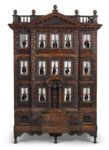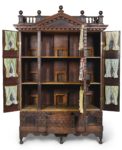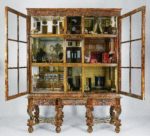 Following the recommendation of the Reviewing Committee on the Export of Works of Art and Objects of Cultural Interest (RCEWA), Britain’s Minister for Arts, Heritage and Tourism has placed a temporary export ban on a rare early Georgian miniature baby house sold at a London auction last May. The owner has applied for an export license so the rare piece will leave the country unless a buyer in the UK can scare up the sum of £78,000 (£65,000 plus £13,000 VAT, about $109,000 total). The ban defers the license application until May 1st. If an interested party is found to have a realistic shot at raising the money, the ban can be extended until August 1st.
Following the recommendation of the Reviewing Committee on the Export of Works of Art and Objects of Cultural Interest (RCEWA), Britain’s Minister for Arts, Heritage and Tourism has placed a temporary export ban on a rare early Georgian miniature baby house sold at a London auction last May. The owner has applied for an export license so the rare piece will leave the country unless a buyer in the UK can scare up the sum of £78,000 (£65,000 plus £13,000 VAT, about $109,000 total). The ban defers the license application until May 1st. If an interested party is found to have a realistic shot at raising the money, the ban can be extended until August 1st.
 What makes this little house worth the effort to keep in the country is that it’s one of only 30 known English baby houses built before 1760 still extant. It was constructed by an anonymous craftsman between 1720 and 1740 in Palladian style, probably modeled after a real house in Richmond although the specific house is unkonwn. Most of it is mahogany, with details in oak and softwood. The windows are glazed. Three hinged doors open to reveal nine rooms on three floors, each with their own fireplace. The central column of rooms are incised with lines to make it look like the walls are wood panelled. The hinged doors have locks, and top quality ones at that. Counting its base with elegantly turned feet, the baby house is 6’8″ high, 4’5″ wide and 2’2″ deep.
What makes this little house worth the effort to keep in the country is that it’s one of only 30 known English baby houses built before 1760 still extant. It was constructed by an anonymous craftsman between 1720 and 1740 in Palladian style, probably modeled after a real house in Richmond although the specific house is unkonwn. Most of it is mahogany, with details in oak and softwood. The windows are glazed. Three hinged doors open to reveal nine rooms on three floors, each with their own fireplace. The central column of rooms are incised with lines to make it look like the walls are wood panelled. The hinged doors have locks, and top quality ones at that. Counting its base with elegantly turned feet, the baby house is 6’8″ high, 4’5″ wide and 2’2″ deep.
 Like other examples of exceptionally detailed and luxurious miniature houses like the Dollhouse of Petronella Oortman (ca. 1686-1710) now in the Rijksmuseum, this Georgian house was not a toy. They were fine, expensive pieces and either kept as curios for adults to enjoy, or used to encourage their young daughters to learn how to run a household.
Like other examples of exceptionally detailed and luxurious miniature houses like the Dollhouse of Petronella Oortman (ca. 1686-1710) now in the Rijksmuseum, this Georgian house was not a toy. They were fine, expensive pieces and either kept as curios for adults to enjoy, or used to encourage their young daughters to learn how to run a household.
The concept of the miniature house came to England from the Netherlands and Germany in the early 18th century, and was intended for training the young daughters of wealthy families in household management. Miniature furniture, and utensils in silver, pewter and porcelain, were supplied by toy merchants, while girls were encouraged to develop sewing skills by making clothes for the house’s dolls.
Due to their intricate and expensive design baby houses were more a training tool than a plaything for children until the early 19th century, when the design was simplified and production increased, resulting in the dolls’ houses of more recent time
Its earliest history is a mystery, but by the 19th century it was at Grove House, Tottenham, home of the Forster family of Quaker educators, philanthropists, reformers and abolitionists. (Fortuitous connection to an earlier blog entry: Prison reformer Elizabeth Fry was inspired to take up the cauuse after she visited Newgate Prison at the behest of William Forster.) It may have belonged to William’s sisters Elizabeth and Sarah Forster. Their nephew, William’s son William Edward, a Member of Parliament who in the fine tradition of his family introduced the Education Act of 1870 and would later become Chief Secretary for Ireland, received it by descent and left it to his daughter Florence. It stayed in the family one more generation after her before being sold to a dealer and entering a private collection.
RCEWA member Peter Barber said:
“This captivating and little altered house in miniature takes us into the elegant eighteenth century home while also shedding unique light on the education of young middle class girls at that time.”
The RCEWA made its recommendation on the grounds of the house’s outstanding significance for the study of the history and material culture of childhood.
It looks decent enough, not even a mattress left abandoned on the floor 😉
It reminds me, oh blogger, that the Beeb has been running a short series on the history of the Royal Collection (of paintings, sculptures, etchings, drawings, and objets d’art). I recommend it, both for the history and the art. It included a very fine “doll’s house” of the sort you describe here.